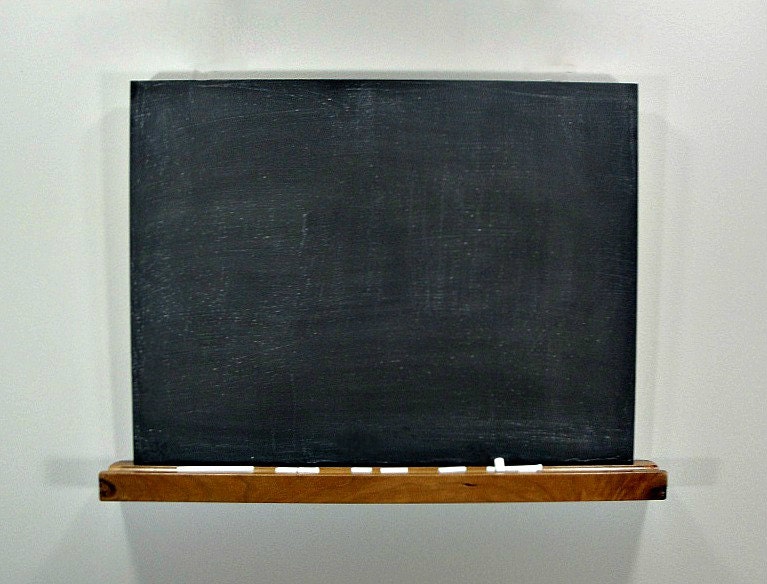I bet you thought it was the calculator or computer. Perhaps some of you thought it was the modern notebook or fountain pen--those last two items were the beginning of mobile learning. Alas, it was the dusty (sometimes streaky and with dead spots) chalk board.
I never thought very much of chalkboards, after all I'm allergic to chalk dust, but after hearing about its effect on education I too need to sing about its merits.
For those of you who have never considered what school was (is) like without one of these pieces of technology, ask yourself this. How did educators draw or write information to share? Remember those amazing geography maps, congregated verbs, and math graphs? Now try and imagine trying to learn about them from someone's verbal description. "So you have this line and it's on a slant, but not a big slant as there wasn't that much change from the first data entry to the second." I can imagine a room full of confused faces: visual learners? They didn't have a chance.
I'm sure some of you reading this are questioning the validity of calling a chalkboard a piece of, granted ancient, technology, but do you know that it came with a teaching manual? I know for some people the litmus test of identifying technology is an operations manual. Wrylie identifies that following the Education Act of the late 19th century, dozens of teaching manuals appeared that not only identified its purposes but gave suggested uses and teaching strategies for this technology. These manuals even included diagrams of what to draw on them ( Wrylie, 2012).
The question I'm left pondering, I wonder what adults thought about this new technology? Were students rolling their eyes as they heard an adult say, "when I was your age, we didn't have any chalkboards." Wait a minute, they probably weren't in school either. Tongue and cheek aside, was this piece of technology the beginning of students and learners becoming too reliant on technology?
It's interesting to think of something as basic as a chalkboard as a piece of technology. Technology can be frightening and frustrating at times in education. New technology requires careful examination before its introduction into teaching, but it's initial arrival can create excitement--I like to think of it as the "new car smell" factor.
Whereas Skinner probably scared educators in the 1950s when he said that his "teaching machines" would make the teacher out of date, Papert in the 1980's made computers sound like theses devices would radically transform schools--same technology, different spin (Sawyer, 2006, p.8). By the 1990's society was pushing for this technology's adoption and integration into the curriculum--the computer like the chalkboard became the essential tool. If you ask educators who watched this technologies original arrival, I wonder what they thought of it and how did they implement its use into their teaching practice? Was it a tool or a toy: did provide real learning opportunities or was it more of a babysitter that was pulled out once in a while? I say this because one of the most repeated statements I hear at tech teachers meetings is the concerns and challenges of our dwindling budgets and we need to justify every equipment purchase. Will it be used consistently to facilitate learning? Can it be used in a multitude of areas or is it "a one trick pony." Andreiessen identifies that any learning tool has to be examined so as to identify the impact it can have on learning for each learner as well as the tool's impact on other learning tools. "We need to avoid falling into the trap of which use is correct and which one is not" (Andreissen, 2006, p. 456-460 ).
I'm sure the validity of the chalkboard as an instructional tool was question when it was first introduced. I think this is good practice with any addition to the teaching tool arsenal--whether it be a new learning theory or gadget. It needs to be examined not only on its own but how it works in the context of other tools and more importantly with the learners themselves and learning is both cognitive and social.
I know that there is more to this, but I need to read some more after some sleep and I get to doodle on a chalkboard. I have the sudden desire to go all old school.
References
(Andreissen, J. (2006). Arguing to Learn. In
R. K. Sawyer (Ed.), The Cambridge Handbook of the Learning Sciences (pp. 443-4). New York, NY: Cambridge University
Press. (Chapter 26)
Wylie, C. (2012). Teaching manuals and the blackboard: accessing
41:2, 257-272, DOI: 10.1080/0046760X.2011.584573

No comments:
Post a Comment
Thank you for giving me your feedback--learning is a two-way process and I'm glad that you decided to be part of the process.